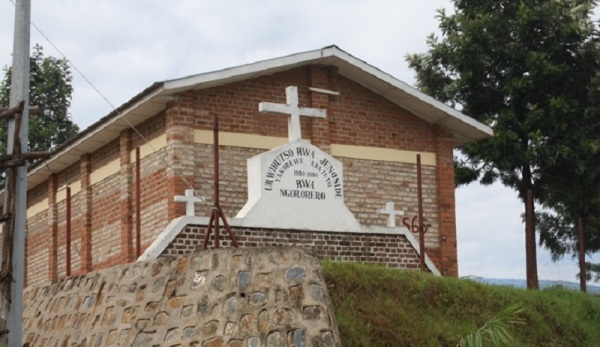
By Dr BIZIMANA Jean Damascène*
In June 1994, in areas that the RPF-INKOTANYI army had not yet taken over, after the killers had finished the massacre of Tutsi did not stop there. They continued to loot and to kill in areas where Tutsi had not been killed. In Ngororero, after the massacre of Tutsi, they left children born to Hutu women and Tutsi men to be inhumanly murdered in June 1994.
1. THE GENOCIDE IN KAVUMU WAS CARRIED OUT WITH THE GREATEST MAGNITUDE
Kavumu was one of the sectors that made up Ramba Commune, in Gisenyi Prefecture, and is one of the most areas populated by Tutsi in Gisenyi. The history of Kavumu shows us that it is an area that had been plagued by violence and killings of Tutsi since 1959, some of whom flew others led destitute living conditions. The 1994 genocide against the Tutsi destroyed almost all the Tutsi in the area; some were killed in churches and buildings of Ramba and Gaseke communes.
The massacre of Tutsi and the brutality of the Genocide is evidenced by the fact that twenty-four thousand one hundred and eighty-eight (24,188) bodies were buried in dignity in the Kavumu memorial. There are also bodies which have not yet been found dumped in various unknown locations and yet the genocide occurred on a day light. An example is that the bodies of Kamanzi and Biraro were found 24 years later.
In 1994, Ramba Commune was ruled by Bourgmestre KARASIRA Leonard who was a member of the MRND party. KARASIRA collaborated with the sous prefect of Ngororero sous prefecture which brought together Satinskyi, Ramba and Kibirira communes, BAZIMAZIKI Bernardin. The Interahamwe were the most prominent in the massacre, and they were many in Ngororero, but they collaborated with Impuzamugambi of the CDR and wore uniforms while going to kill Tutsi.
Among the Tutsi killed were the family of Kabirigi who were killed by their neighbours, the family of Binama, family of Munyakayanza Isidore who was a teacher, Ntiyamira Leonard and his family, the family of Kagaragu, Mudahangarwa, Gatsimbanyi, Rutayisire, Sebagaramba, Uwiringiyimana, Nshimiyimana, Nsengiyumva, Nyamugira, Ndamage, Kayitsinga, Zaninkwano, Gatari, Nyiraromba, Bukamba, Uwonkunda Annonciata, Kamirindi, Furere and his two children, Kayibanda Mathieu, Murengerantwari and others.
Twenty others from Dativa Uwamwiza family were first buried in the cemetery near Mukore wa Rwabugiri but in 2018 the bodies were transferred to Kibirira memorial.
The Kavumu memorial contains the bodies of 374 Tutsi, but not only them were killed there, but others have been buried in other memorials either Ngororero, Kabaya or Kibirira.
The Interahamwe and Impuzamugambi collaborated in all the massacres in Ramba, especially in the Sovu and Bayi sectors and they were led by BARAKOMERA but supported by those from Gaseke and Satinskyi communes.
Most of the Interahamwe were from Ngororero and they were led by KABALIRA Telesphore, a school inspector who also headed the Interahamwe in Satinskyi Commune, and his wife, MUKARUZIGA Eugenie, was the Vice President of the CDR in Satinskyi and this is where Ngororero sous prefecture headquarter was.
MBARUSHIMANA Bonaventure, a former businessman and MRND President in the Mucano sector, played a key role in the massacre of Tutsi in various parts of the country as he had given his car to transport Interahamwe and Impuzamugambi to kill.
Another major interahamwe genocide perpetrator in Ngororero was NYANDWI Jean Claude who was a teacher at Kavumu Primary School in Ramba Commune.
2. CHILDREN BORN OF HUTU WOMEN WHO HAD MARRIED TUTSI MEN WERE INHUMANLY KILLED AFTER ALL OTHER TUTSI
In the Rwandan culture followed in 1994, the child took the father’s ethnic group and was the one recorded in the identity card of the adult child. This meant that when a Tutsi man married a Hutu woman, the children he gave birth to were of Tutsi ethnic group. When a Hutu man married a Tutsi woman, the children he gave birth to were Hutu in their identity cards. As a result, during the Genocide, children born to Tutsi men and Hutu women were treated as Tutsi, and even killed in the same way as Tutsi for the blood of their fathers.
On June 8, 1994, the Interahamwe of MRND in collaboration with the Impuzamugambi of CDR who had already massacred Tutsi, including many men who had married Hutu women, also demolished their homes.
The Interahamwe killed Tutsi in early April 1994, they took the children of Tutsi men (whom they had killed) who had married Hutu women and put them in the same house and ordered their mothers to guard them. But in order to ensure that the women would not escape, they left few Interahamwe control them.
They were 13 children including small children and infants. On June 8, 1994, the Interahamwe came to kill the children and their mothers and only one child could survive. They were cruelly killed because some of them were thrown into a pit they had excavated and buried alive, and their Hutu mothers were ordered by Interahamwe to return home.
CONCLUSION
Ngororero was greatly ruled by the MRND party and its palace was located nearby the former Ngororero sous prefecture building. That is why the Interahamwe and its leaders from the sous prefect to the Councillors were the dominant leaders in the genocide against the Tutsi. (End).
*Dr BIZIMANA Jean Damascène, Executive Secretary National Commission for the Fight against Genocide (CNLG)
